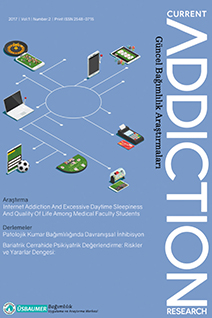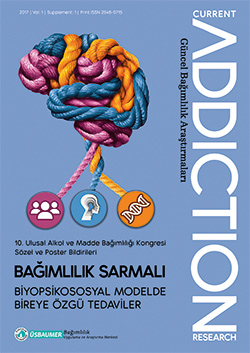ARTICLES
Original Article
Mine Ergelen,Didem Beşikçi Keleş,Murat Yalçın,Melike Yerebakan Tüzer,Tuba Öcek Baş,Ekin Sönmez Güngör,Davut Genç,Merve Metin,Aslı Kayacan
2024, 8(1), s:13-19
Objective: Tobacco use, which has been one of the leading causes of preventable death and disability worldwide for many years, increases susceptibility and transmission risk in respiratory infections such as COVID-19, negatively affecting the prognosis. World Health Organization (WHO) recommends quitting smoking or reducing daily consumption, especially during the pandemic, to reduce potential harm. The aim of our study is to present our experience with the application of nicotine replacement therapy (NRT) and the course of psychiatric illness in hospitalized smokers with severe mental illness and COVID-19. Considering the recent pandemic, it is crucial to recommend smoking cessation and provide treatment support to psychiatric patients with severe mental illness accompanied by physical illnesses, infectious diseases, and especially COVID-19 infection, to achieve better outcomes in the treatment of comorbidities and infections.
Method: Our study included 18 smoking patients out of 23 with severe mental illness who were hospitalized in the psychiatric ward and had COVID-19 infection. Records of patients who received NRT were retrospectively reviewed. The severity of nicotine dependence was assessed using the Fagerström Test for Nicotine Dependence (FTND), and agitation was evaluated using the Excited Component Subscale of the Positive and Negative Syndrome Scale (PANSS-EC). PANSS-EC scores at baseline and on day 7 were compared. FTND scores at baseline and on day 30 post-discharge were compared. The correlation between FTND and variables such as the rate of reduction in PANSS-EC and length of hospital stay was investigated.
Results: Two-thirds of the patients had high nicotine dependence with FTND scores ≥ 6. At the end of the first week, an average reduction of 43.1% in PANSS-EC scores was observed. A moderate positive correlation was found between baseline FTND scores and the reduction rate in PANSS-EC scores, and a moderate negative correlation between baseline FTND scores and duration of hospitalization. On the 30th day after discharge, it was found that all patients had resumed smoking, with 44% having FTND scores ≥ 6. A significant decrease was observed when comparing baseline FTND scores with FTND scores on the 30th day post-discharge.
Conclusion: It is important to consider nicotine withdrawal symptoms in patients who smoke and are admitted to a psychiatric unit where tobacco use is restricted, and to consider NRT as part of the inpatient treatment programme. However, according to our results, NRT alone is not sufficient for smoking cessation treatment. It should be supported by motivational interviewing, individual counselling or psychoeducation. In addition, the fact that the patients in our study quit smoking with acute and extrinsic motivation due to COVID-19 infection may be one of the factors that caused them to relapse after discharge. Therefore, comprehensive smoking cessation treatment and NRT for psychiatric patients should be an integral part of inpatient treatment programmes during and after the pandemic.



 2. Sayı
2. Sayı
 1. Sayı
1. Sayı
 Ek Sayı
Ek Sayı







